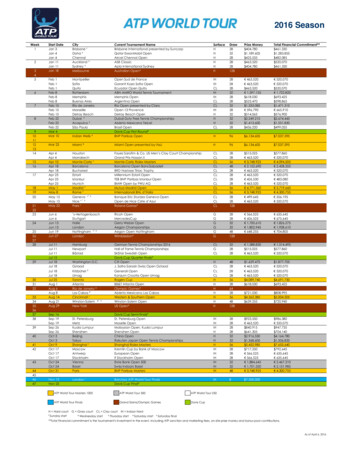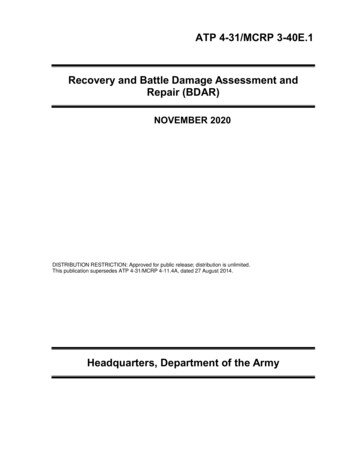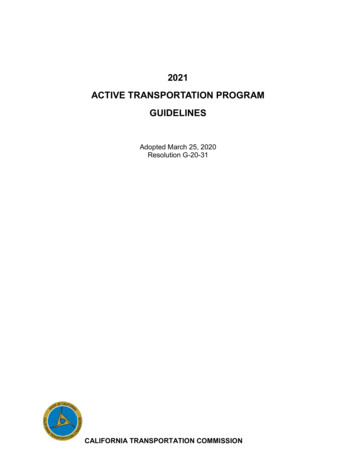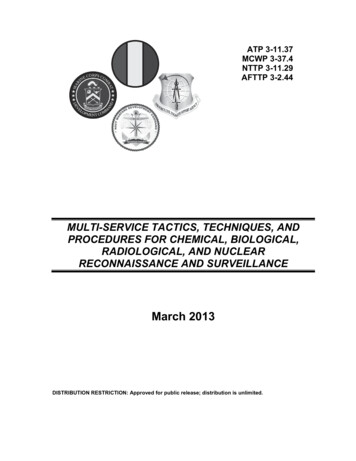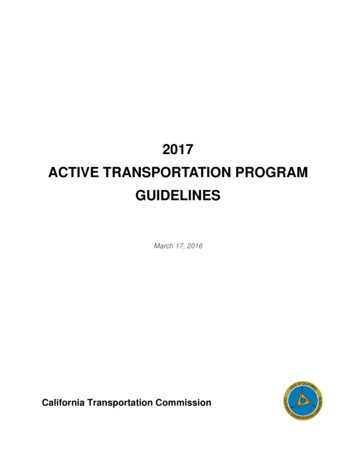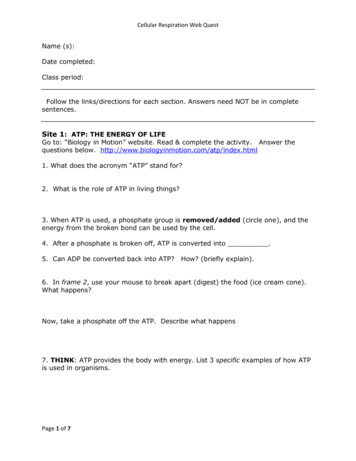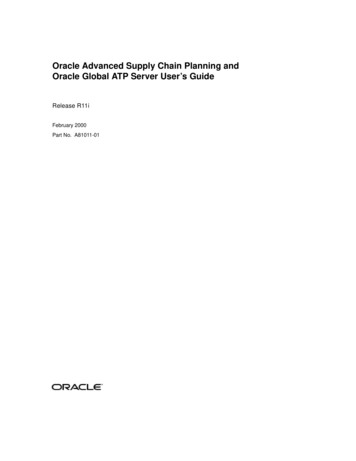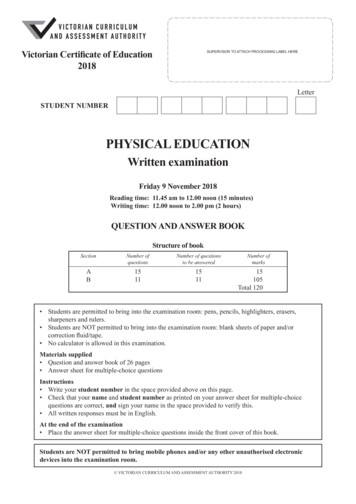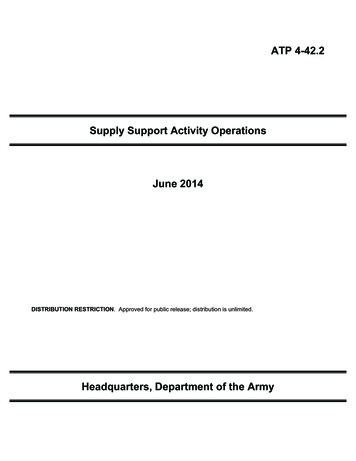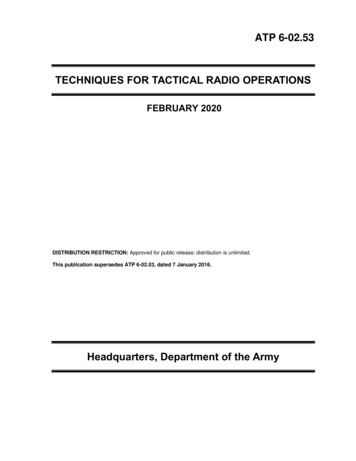
Transcription
ATP 6-02.53TECHNIQUES FOR TACTICAL RADIO OPERATIONSFEBRUARY 2020DISTRIBUTION RESTRICTION: Approved for public release; distribution is unlimited.This publication supersedes ATP 6-02.53, dated 7 January 2016.Headquarters, Department of the Army
This publication is available at the Army Publishing DirectorateWebsite (https://armypubs.army.mil/) and the Central Army Registrysite (https://atiam.train.army.mil/catalog/dashboard).
*ATP 6-02.53Army Techniques PublicationNo. 6-02.53HeadquartersDepartment of the ArmyWashington, DC, 13 February 2020Techniques for Tactical Radio OperationsContentsPagePREFACE. viiINTRODUCTION . ixChapter 1OVERVIEW . 1-1Tactical Radios . 1-1Tactical Radio Networks . 1-2Network Management Planning Tools . 1-4Capabilities . 1-6Land Mobile Radio . 1-6Combat Survivor Evader Locator . 1-7Chapter 2TACTICAL RADIO EMPLOYMENT BY ECHELON . 2-1Combatant Commander Communications Team . 2-1Signal Command (Theater) . 2-3Corps and Below . 2-4Special Operations Forces . 2-5Tactical Command Post . 2-6Chapter 3TACTICAL RADIO PLATFORMS . 3-1Section I – Legacy and Enduring Radio Platforms . 3-1Single-Channel Ground and Airborne Radio System . 3-1Defense Advanced Global Positioning System Receiver. 3-12MicroLight Personal Software-Defined Networked Radio . 3-13High Frequency Radios . 3-13Blue Force Tracking . 3-18Force XXI Battle Command, Brigade and Below Joint Battle Command Platform . 3-19Force XXI Battle Command, Brigade and Below Joint Capabilities Release . 3-19Section II – Software Defined Radio Platforms . 3-19Handheld Manpack Small Form Fit . 3-20Manpack Radio . 3-21Chapter 4WAVEFORMS AND WAVEFORM APPLICATIONS . 4-1Lower Tier Waveforms . 4-1Waveform Applications . 4-2Chapter 5VHF RADIOS . 5-1Multiband Inter/Intra Team Radio . 5-1Wideband Networking Handheld Radio . 5-2Multichannel Manpack Radio . 5-3DISTRIBUTION RESTRICTION: Approved for public release; distribution is unlimited.*This publication supersedes ATP 6-02.53, dated 7 January 2016.ATP 6-02.53i
PrefaceChapter 6ULTRAHIGH FREQUENCY RADIOS . 6-1Multifunctional Information Distribution System . 6-1Tactical Digital Information Link Joint Terminals . 6-1Joint Tactical Information Distribution System . 6-2Battlefield Awareness and Targeting System-Dismounted . 6-3Chapter 7AIRBORNE RADIOS . 7-1AN/ARC-201 Radio . 7-1AN/ARC-210 Radio . 7-1AN/ARC-220 Radio . 7-2AN/ARC-231 Radio . 7-2AN/ARC-186 Radio . 7-3Chapter 8ANTENNA TECHNIQUES . 8-1Antenna Techniques Overview . 8-1High Frequency Antenna Location Considerations . 8-1Ground Effects . 8-9Grounded Antenna Theory . 8-10Antenna Length . 8-12Antenna Orientation . 8-13Improvement of Marginal Communications . 8-15Types of Antennas . 8-15Field Repair . 8-30Chapter 9TACTICAL RADIO KEY MANAGEMENT . 9-1Key Management Infrastructure . 9-1Key Distribution . 9-2Automated Communications Engineering Software . 9-2Loadsets . 9-4Chapter 10ELECTRONIC WARFARE AND PROTECTION TECHNIQUES . 10-1Electronic Warfare. 10-1Electronic Protection Responsibilities . 10-3Communications Planning Process . 10-5Signal Security . 10-7Emission Control . 10-7Preventive Electronic Protection Techniques . 10-8Single-Channel Ground and Airborne Radio System Anti-Jamming . 10-14Electronic Warfare for Single-Channel Tactical Satellite . 10-15Counter Radio-Controlled Improvised Explosive Device Electronic Warfare . 10-17Purposeful Interference . 10-17Electromagnetic Interference . 10-17Appendix AFREQUENCY MODULATION RADIO NETWORKS . A-1Appendix BSINGLE-CHANNEL RADIO COMMUNICATIONS TECHNIQUES . B-1Appendix CANTENNA SELECTION . C-1Appendix DCOMMUNICATIONS IN AUSTERE ENVIRONMENTS . D-1Appendix EJULIAN DATE, SYNCHRONIZATION TIME, AND TIME CONVERSION . E-1Appendix FRADIO COMPROMISE RECOVERY PROCEDURES . F-1Appendix GDATA COMMUNICATIONS .G-1Appendix HCOSITE INTERFERENCE . H-1Appendix IRADIO OPERATING PROCEDURES . I-1Appendix JFIELD REPAIR OF ANTENNAS . J-1iiATP 6-02.5313 February 2020
PrefaceAppendix KSINGLE-CHANNEL TACTICAL SATELLITE COMMUNICATIONS . K-1GLOSSARY . Glossary-1REFERENCES . References-1INDEX . Index-1FiguresFigure 3-1. Retransmission operations . 3-10Figure 3-2. Defense Advanced Global Positioning System receiver . 3-13Figure 8-1. Transmitter and receiver connection example . 8-2Figure 8-2. Components of electromagnetic waves . 8-3Figure 8-3. Solid radiation patterns . 8-4Figure 8-4. Vertically polarized wave . 8-5Figure 8-5. Horizontally polarized wave . 8-6Figure 8-6. Circular polarization . 8-7Figure 8-7. Antenna take-off angle . 8-9Figure 8-8. Quarter-wave antenna connected to ground . 8-10Figure 8-9. Wire counterpoise . 8-12Figure 8-10. Beamwidth . 8-14Figure 8-11. Example of a declination diagram . 8-14Figure 8-12. Near-vertical incidence skywave antenna, AS-2259/GR . 8-16Figure 8-13. V antenna . 8-17Figure 8-14. Vertical half-rhombic antenna . 8-18Figure 8-15. Long-wire antenna . 8-19Figure 8-16. Sloping-V antenna . 8-20Figure 8-17. Inverted L antenna . 8-21Figure 8-18. Near-vertical incidence skywave propagation . 8-22Figure 8-19. Whip antenna . 8-23Figure 8-20. Whip antennas mounted on a vehicle. 8-24Figure 8-21. OE-303 half-rhombic VHF antenna . 8-26Figure 8-22. Half-wave dipole (doublet) antenna . 8-27Figure 8-23. Center-fed half-wave antenna . 8-28Figure 8-24. Improvised vertical half-wave antenna . 8-29Figure 8-25. Field repair of broken whip antennas . 8-31Figure 8-26. Examples of field expedient antenna insulators . 8-32Figure 8-27. Repaired antenna guy lines and masts . 8-33Figure 10-1. Local interference resolution (Army victim) . 10-19Figure 10-2. Interference resolution (Army source) . 10-20Figure A-1. Structure of a division command network .A-3Figure A-2. Example of a brigade administrative and logistics network.A-4Figure A-3. Example of a division operations and intelligence communications network.A-513 February 2020ATP 6-02.53iii
PrefaceFigure A-4. Example of a corps medical operations network . A-6Figure A-5. Example of a medical operations network in a division . A-7Figure A-6. Example of a division sustainment area command network . A-8Figure A-7. Example of a division HF command network . A-9Figure A-8. Example of a cavalry squadron HF data network . A-10Figure B-1. Radiation of radio waves from a vertical antenna . B-3Figure B-2. Wavelength of a radio wave. B-3Figure B-3. Principal paths of radio waves . B-4Figure B-4. Possible routes for ground waves . B-4Figure B-5. Average layer distribution of the ionosphere . B-6Figure B-6. Skywave transmission paths . B-8Figure B-7. Skywave transmission hop paths. B-9Figure B-8. Wave shapes . B-13Figure B-9. Amplitude modulation system . B-14Figure B-10. Single-sideband system . B-15Figure C-1. 32-foot vertical whip, vertical antenna pattern . C-3Figure E-1. World time zone map . E-5Figure H-1. Possible antenna stacks . H-3Figure J-1. Field repair of broken whip antennas .J-1Figure J-2. Examples of field expedient antenna insulators .J-2Figure J-3. Repaired antenna guy lines and masts .J-3Figure K-1. Single-Channel Anti-Jam Man-Portable terminal interface with combat net radio . K-4TablesTable 3-1. Comparison of SINCGARS versions and components . 3-3Table 3-2. SINCGARS enhancements comparison . 3-5Table 3-2. SINCGARS enhancements comparison (continued) . 3-6Table 3-3. Minimum antenna separation distance . 3-11Table 3-4. AN/VRC-100 configurations . 3-15Table 3-5. Automatic link establishment system handshake . 3-17Table 3-6. Notional link quality analysis matrix for a radio (B3B) . 3-17Table 8-1. Antenna length calculations . 8-13Table 8-2. Leg angle for V antennas . 8-18Table 8-3. Frequency and inverted L horizontal element length . 8-20Table 8-4. OE-254 planning ranges . 8-25Table 9-1. Initializing Automated Communications Engineering Software or communicationselectronics operating instructions and signal operating instructions data . 9-4Table 10-1. Techniques for minimizing transmissions and transmission times . 10-9Table 10-2. Common jamming signals . 10-12Table 10-3. Army interference resolution program functions . 10-18ivATP 6-02.5313 February 2020
PrefaceTable 10-4. Joint spectrum interference resolution security classification guide . 10-21Table 10-5. Joint spectrum interference resolution information requirements . 10-22Table A-1. Example of division command networks .A-2Table B-1. Surface conductivity.B-5Table B-2. Ionosphere layers .B-6Table B-3. Regular variations of the ionosphere .B-7Table B-4. Irregular variations of the ionosphere .B-7Table C-1. Take-off angle versus distance . C-2Table C-2. HF antenna selection matrix . C-4Table E-1. Two-digit Julian date calendar (regular year) .E-2Table E-2. Two-digit Julian date calendar (leap year) .E-3Table E-3. Example of world time zone conversion (standard time) .E-4Table F-1. Compromised network recovery procedures: compromised transmission encryptionkeys and key encryption keys . F-2Table F-2. Compromised network recovery procedures: compromised transmission encryptionkeys F-3Table H-1. Transmitters and transmission range with and without the frequency hoppingmultiplexer . H-4Table I-1. Phonetic alphabet . I-1Table I-2. Numerical pronunciation . I-2Table I-3. Numerals in combinations . I-2Table I-4. Procedure words listed alphabetically. I-3Table K-1. AN/PSC-5/C/D, AN/PRC-117F and AN/ARC-231 line of sight interoperability .K-7Table K-2. AN/PSC-5/C/D, AN/ARC-231 and AN/PRC-117F .K-813 February 2020ATP 6-02.53v
This page intentionally left blank.
PrefaceATP 6-02.53 is the primary doctrine publication for tactical radios and tactical radio networks. Thispublication describes the non-prescriptive methods to perform missions, functions, and tasks for theemployment of tactical radio networks to support every warfighting function and enable command andcontrol of Army forces.This publication includes doctrine on new communications and networking capabilities. It addresses theemployment of interdependent and interoperable enterprise and tactical systems in the tactical network.This publication supports the Army’s goal to provide an integrated network that is interoperable acrossall mission environments during all phases of operations. This publication implements North AtlanticTreaty Organization standardization agreement 4538, Technical Standards for an Automatic RadioControl System for High Frequency Communication Links.The principal audience for ATP 6-02.53 is commanders, staffs, supervisors, planners, radio operators,signal Soldiers, and other personnel responsible for operating tactical radios or employing tactical radionetworks across multiple domains, at all echelons. ATP 6-02.53 is a standard reference for tactical radios.It provides system planners with guidance and steps for network planning, interoperabilityconsiderations, and equipment capabilities.Commanders, staffs, and subordinates ensure that their decisions and actions comply with applicableUnited States, international, and in some cases host-nation laws and regulations. Commanders at alllevels ensure that their Soldiers operate in accordance with the law of war and the rules of engagement.(See FM 6-27.)ATP 6-02.53 uses joint terms where applicable. Selected joint and Army terms and definitions appear inboth glossary and the document. Terms for which ATP 6-02.53 is the proponent publication (theauthority) are italicized in the text and marked with an asterisk (*) in the glossary. Terms and definitionsfor which ATP 6-02.53 is the proponent publication are boldfaced in the text. For other definitions shownin the text, the term is italicized and the number of the proponent publication follows the definition.ATP 6-02.53 applies to the Regular Army, Army National Guard/Army National Guard of the UnitedStates, and United States Army Reserve unless otherwise stated.The proponent for this publication is the United States Army Cyber Center of Excellence. The preparingagency is the Doctrine Branch, United States Army Cyber Center of Excellence. Send comments andrecommendations on a DA Form 2028 (Recommended Changes to Publications and Blank Forms) toCommander, United States Army Cyber Center of Excellence and Fort Gordon, ATTN: ATZH-OP (ATP6-02.53), 506 Chamberlain Avenue, Fort Gordon, GA 30905-5735; or e-mail to mail.mil.13 February 2020ATP 6-02.53vii
This page intentionally left blank.
IntroductionATP 6-02.53 expands on the foundational information about tactical radios in FM 6-02. Tactical radiosare critical command and control enablers in unified land operations. Radio networks empowersubordinate decision making through the mission command approach. Tactical radio networkssynchronize and integrate the elements of combat power across all domains and the informationenvironment. Tactical radios and networks support the Army’s strategic roles to shape operationalenvironments, prevent conflict, conduct large-scale combat operations, and consolidate gains against apeer threat.Fluid tactical situations in sustained operations require versatile and adaptable tactical radios. Tacticalradios provide Army forces the capability to move and communicate from higher echelons down to thesquad level. Squad-level radios enable communication and situational awareness at the lowest levelpossible. This publication presents techniques for Soldiers to execute the Signal Corps’ core competencyassociated with network transport. This revision of ATP 6-02.53 includes updated information to addressnew or modified single-channel radio systems.ATP 6-02.53 has ten chapters and eleven appendixes—Chapter 1 provides an overview of tactical radios, tactical radio networks, capabilities, and networkmanagement.Chapter 2 addresses the employment of tactical radios at all echelons of the Army.Chapter 3 addresses the tactical radio platforms and associated waveforms that Army forces employ atall echelons across all phases of operations.Chapter 4 discusses the waveform and waveform application functional component of the tacticalnetworking environment.Chapter 5 describes the commercial off-the-shelf VHF radios used to support tactical radio operations.Chapter 6 addresses the ultrahigh frequency radios and systems that play a significant role in networkcentric warfare.Chapter 7 addresses the airborne radios employed to provide communications for ground-to-airoperations, air-to-air, and air-to-sea missions.Chapter 8 addresses antenna techniques, concepts, terms, types, effects, and provides examples ofantenna field repairs.Chapter 9 addresses key management techniques when protecting voice, data, and video informationover tactical radio networks.Chapter 10 addresses electronic warfare and the electronic protection techniques used to prevent enemyjamming and intrusion into friendly communications systems.Appendix A describes frequency modulation networks.Appendix B identifies radio sets essential components, characteristics, properties of radio waves, wavemodulation, and site considerations for single-channel radios.Appendix C addresses HF, VHF, UHF antennas.Appendix D addresses radio operations in unusual environments.Appendix E addresses the Julian date, synchronization time, and ZULU time. It also provides a timezone conversion chart.13 February 2020ATP 6-02.53ix
Chapter 1Appendix F provides procedures for preventing a network compromise and addresses recovery optionsavailable to the commander and staff.Appendix G addresses data communications elements as binary data, baud rate, modems, and forwarderror correction.Appendix H addresses single-channel ground airborne radio system implications and cosite interferencemitigation.Appendix I addresses the proper way to pronounce letters and numbers when sending messages overthe radio and the proper procedures for opening and closing a radio net.Appendix J provides recommendations on repairing antennas and antenna supports.Appendix K consists of tactical satellites, communications planning considerations, ultrahigh frequencyterminals, fire support networks, and airborne and air assault units.xATP 6-02.5313 February 2020
Chapter 1OverviewThis chapter introduces tactical radio operations, radio networks, and radio networkmanagement across all phases of operations to support warfighting functions. Radiosare not stand-alone capabilities, but they are complete interoperable networks thatprovide commanders with a mobile ad hoc networking environment.TACTICAL RADIOS1-1. Tactical radios are a necessity for Soldiers during military operations. Squad leaders and higher usetactical radios to communicate and share a common view of the operational environment. Tactical radiosprovide Soldiers the ability to send and receive voice, data, and video communication. Tactical radio systemsare the primary means for Soldiers to communicate during operations.TACTICAL RADIOS IN ARMY OPERATIONS1-2. Army forces employ a variety of tactical radios and waveforms to shape operational environments,prevent conflict, conduct large-scale combat operations, and consolidate gains in operations in multipledomains. Tactical radios and waveforms support the Army’s enterprise initiative to be an integrated andinteroperable network from the highest to the lowes
TECHNIQUES FOR TACTICAL RADIO OPERATIONS FEBRUARY 2020 DISTRIBUTION RESTRICTION: Approved for public release; distribution is unlimited. This publication supersedes ATP 6-02.53, d
